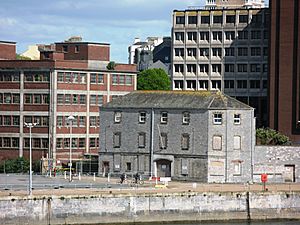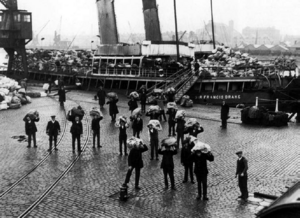Millbay facts for kids
Millbay, also known as Millbay Docks, is a busy area of docks in Plymouth, England. It's located south of Union Street, between West Hoe to the east and Stonehouse to the west. Today, Millbay is being rebuilt with new homes, businesses, a marina for boats, and a large school. The goal is to open up the waterfront so more people can enjoy it.
Millbay's Early Days
Millbay started as a natural bay, much bigger than the docks you see today. It included a large tidal salt-marsh called "Sourepool." A narrow strip of land separated the Sourepool from the bay. Here, people built tidal mills, probably in the 1100s. These mills used the ocean's tides to grind corn.
Later, in the 1500s, Francis Drake bought the mills. He built new mills nearby and the old tidal mills closed. The Sourepool was then drained and turned into a meadow in 1592.
During the English Civil War (1642-1646), Plymouth supported Parliament and was under attack by the Royalist army. Millbay was the only harbor in Plymouth that the Royalist cannons couldn't reach. This made it the only way for supplies to get into the town.
After the war, Millbay became a quiet place again. It didn't have any docks or special port buildings. But in 1756, a famous engineer named John Smeaton built a small dock and work area. He used this spot to unload and prepare stones for the third Eddystone Lighthouse. A special ship called the Eddystone Boat carried the stones out to the lighthouse.
Smeaton's lighthouse was finished in 1759. Around this time, some fun places were built nearby, like the Long Room (a place for parties and meetings), a bath house, and a bowling green. Only the Long Room is still standing today. North of it, the Stonehouse Barracks were built for soldiers. They had a special gate that led straight into Millbay, where soldiers would get on ships.
Millbay Grows in the 1800s
In the late 1830s, there was a small "Union Dock" at Millbay. Then, in 1840, a law allowed Thomas Gill to build a pier and make the bay deeper. Gill had a stone quarry nearby. The pier he built, now called Millbay Pier, was about 150 meters (500 feet) long and finished in 1844. The very next year, the famous ship SS Great Britain docked here on its first trip to New York. About 15,000 people came to see it!
In 1846, another law created the Great Western Dock Company. This company aimed to build full shipping facilities at Millbay. Thomas Gill sold his pier to this company and became a director. Isambard Kingdom Brunel, a famous engineer, was hired to design the new docks. Since Brunel and Gill were also involved with the South Devon Railway Company, it made sense that Plymouth's first train station opened nearby in 1849. A year later, a railway line was built right to the new docks. This meant goods and mail could be easily moved between ships and trains.
Brunel then built another pier, a floating iron platform about 91 meters (300 feet) long. This was for the Irish Steamship Company, whose ships used the harbor often. Next, he built the inner basin with strong stone walls. It had special gates and a drydock (a dock that can be drained of water for ship repairs). This large basin opened in 1857.
Millbay became a very busy commercial dock. It could handle bigger ships than other nearby ports. Many different goods were moved through Millbay, with grain always being an important import. It was also a major place for ships to get coal in the English Channel. A lot of shipbuilding happened here too. For example, Willoughby Bros Ltd. built ships for the Royal Mail and others from 1857 to 1969.
Ocean Liners and Mail Ships
From the 1870s until World War II, Millbay was a key stop for wealthy travelers from the USA. Instead of sailing all the way to Southampton or Tilbury, they would get off their huge transatlantic ships in Plymouth Sound. Smaller boats called tenders would bring them ashore to Millbay. From there, they could catch fast trains from Millbay station directly to London Paddington. This saved a lot of travel time! People called it "the route which cuts the corners off."
This was a huge business! In the 1900s, over six million passengers arrived or left from Millbay. Sometimes, as many as 800 passengers would come off just one ship. The busiest year for these big ships was 1930, with 788 ship visits to Plymouth. Millions of mailbags were also handled here.
The railway company quickly saw how important this traffic was. They started ordering their own special steamers to carry passengers and mail. The first was the Sir Francis Drake in 1873, followed by others like the Sir Walter Raleigh and the Sir John Hawkins. The Sir John Hawkins, built in 1929, was a large ship that could travel about 26 kilometers per hour (14 knots).
A sad and secret event happened here on April 28, 1912. Most of the surviving crew members from the RMS Titanic disaster quietly got off their ship at Millbay. They were then taken by train to Southampton.
Millbay Today
Today, Millbay has two large, deep docks. One of them is partly owned by Brittany Ferries, a company that has its UK main office here. Since 1973, Brittany Ferries has run ferry services from Millbay to Roscoff in France and Santander in Spain. Ferries leave and arrive daily from March to October, and less often in winter.
The dock was made bigger in 2003 to fit Brittany Ferries' new flagship, the 40,000-ton Pont-Aven. The ferry terminal building was also updated. The Pont-Aven now shares the dock with the newer Armorique. Sometimes, other Brittany Ferries ships, like the Bretagne or the fast Normandie Express, visit Millbay too.
Millbay is also home to the Plymouth RNLI (Royal National Lifeboat Institution) lifeboats. They have been based here since 1862. For many years, a huge grey concrete grain silo with a tall tower was a landmark at the harbor entrance. It was taken down in early 2008.
Millbay is currently changing a lot. The area is being redeveloped because it's seen as a very important place for Plymouth's future. Its location by the water, close to the city center, makes it a great opportunity for new growth.






